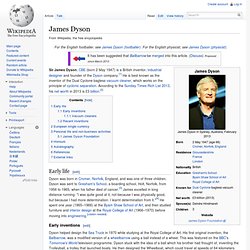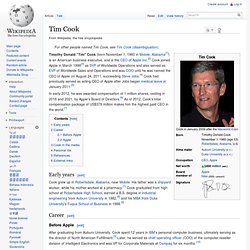

Alec Issigonis. Sir Alexander Arnold Constantine Issigonis, CBE, FRS,[1] RDI (18 November 1906 – 2 October 1988) was a Greek-British designer of cars, now remembered chiefly for the groundbreaking and influential development of the Mini, launched by the British Motor Corporation (BMC) in 1959.

Early life[edit] The machine factory (shown here in a company letter of 1910) founded by Demosthenis Issigonis, Alec's grandfather, was one of the thriving Greek businesses in Smyra (now Izmir). Issigonis was born into the Greek community of Smyrna (now İzmir, Turkey) in the Ottoman Empire. His grandfather Demosthenis Issigonis migrated to Smyrna from Paros in the 1830s and through the work he did for the British-built Smyrna-Aydın Railway, in the engineering works [2] that he had established, had managed to acquire British nationality.
James Dyson. Early life[edit] Dyson was born in Cromer, Norfolk, England, and was one of three children.

Dyson was sent to Gresham's School, a boarding school, Holt, Norfolk, from 1956 to 1965, when his father died of cancer.[3] James excelled in long distance running: "I was quite good at it, not because I was physically good, but because I had more determination. I learnt determination from it. "[4] He spent one year (1965–1966) at the Byam Shaw School of Art, and then studied furniture and interior design at the Royal College of Art (1966–1970) before moving into engineering.
Early inventions[edit] Dyson helped design the Sea Truck in 1970 while studying at the Royal College of Art. Vacuum cleaners[edit] DC07 Dyson vacuum cleaner In the late 1970s, Dyson had the idea of using cyclonic separation to create a vacuum cleaner that would not lose suction as it picked up dirt. Following his success, other major manufacturers began to market their own cyclonic vacuum cleaners.
Tim Cook. Timothy Donald "Tim" Cook (born November 1, 1960 in Mobile, Alabama[1]) is an American business executive, and is the CEO of Apple Inc.[2] Cook joined Apple in March 1998[3] as SVP of Worldwide Operations and also served as EVP of Worldwide Sales and Operations and was COO until he was named the CEO of Apple on August 24, 2011, succeeding Steve Jobs.[4] Cook had previously served as acting CEO of Apple after Jobs began medical leave in January 2011.[5]

Jonathan Ive. Sir Jonathan Paul "Jony" Ive, KBE RDI (born 27 February 1967)[1] is an English designer and the Senior Vice President of Design at Apple Inc.

He oversees the Industrial Design Group, and also provides leadership and direction for Human Interface (HI) software teams across the company.[2] He is the designer of many of Apple's products, including the MacBook Pro, iMac, MacBook Air, iPod, iPod Touch, iPhone, iPad, iPad Mini and iOS 7. Steve Jobs considered Ive to be his "spiritual partner at Apple," while Fortune magazine stated in 2010 that Ive's designs have "set the course not just for Apple but for design more broadly. "[3][4][5] Early life[edit] Ive was born in Chingford, London, UK. Ive explained that his discovery of the Apple Mac, after "having a real problem with computers" during his later student years, was a turning point. Career[edit] The scheduled publication of an unofficial Ive biography was announced in late 2013.
Steve Jobs. American entrepreneur and co-founder of Apple Inc.

Steven Paul Jobs (; February 24, 1955 – October 5, 2011) was an American business magnate, industrial designer, investor, and media proprietor. He was the chairman, chief executive officer (CEO), and co-founder of Apple Inc., the chairman and majority shareholder of Pixar, a member of The Walt Disney Company's board of directors following its acquisition of Pixar, and the founder, chairman, and CEO of NeXT. Jobs is widely recognized as a pioneer of the personal computer revolution of the 1970s and 1980s, along with Apple co-founder Steve Wozniak.
Jobs and Wozniak co-founded Apple in 1976 to sell Wozniak's Apple I personal computer. Together the duo gained fame and wealth a year later with the Apple II, one of the first highly successful mass-produced microcomputers. Background Biological and adoptive families Jobs's adoptive father, Paul Reinhold Jobs,[8] was a Coast Guard mechanic. Birth Childhood —Steve Jobs[18] Homestead High Reed College.